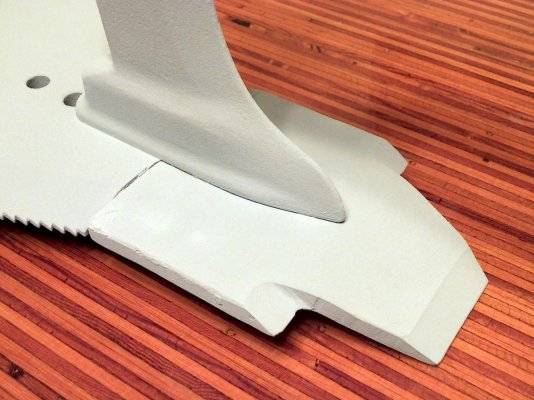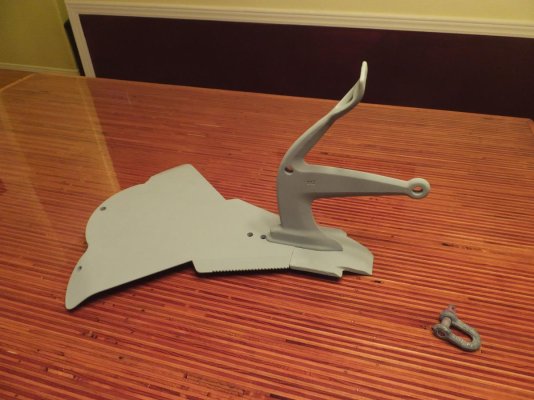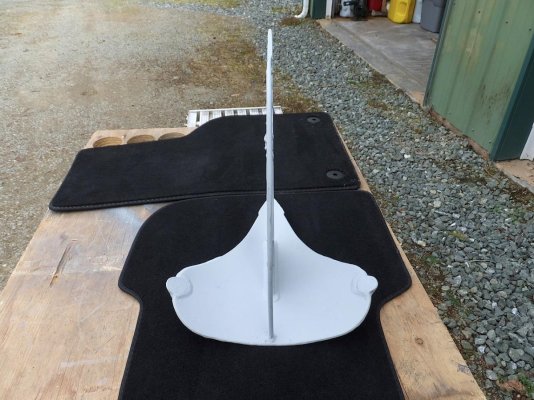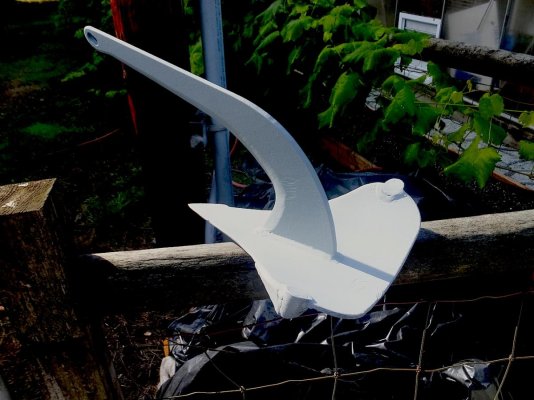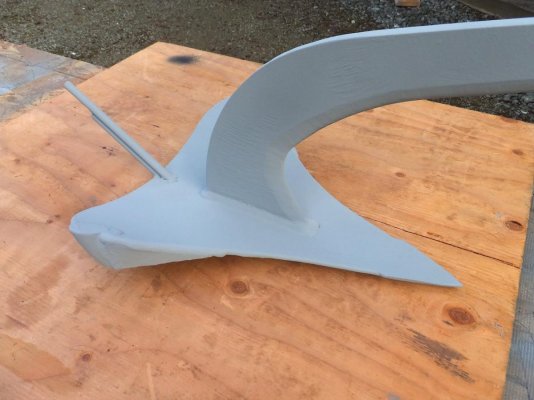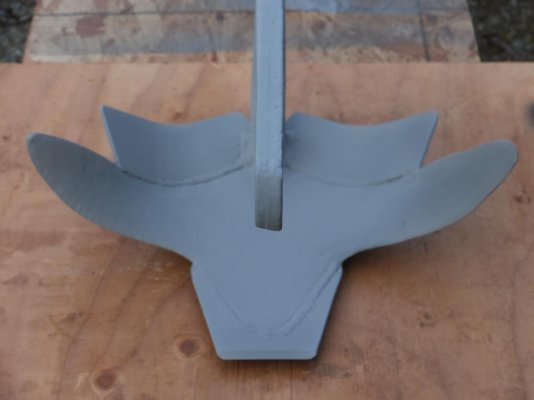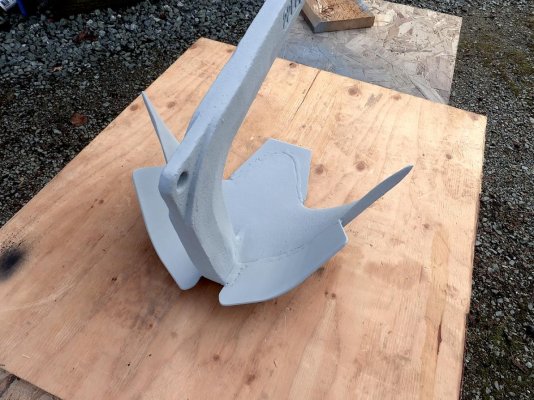Nomad Willy
Guru
Three modified anchors are ready to go and on the boat. We have 4 days of teen temps and four days of snow. But after that?
The three anchors are an old standby of mine the XYZ, the much modified Manson Supreme and my most recent plaything .. a modified Claw.
First the XYZ.
This is an anchor I started using about 12yrs ago. I got one of their first (I think it is their first model) shown as the last pic. On our way to Alaska we got into a 50 knot gale and anchored at the top of Queen Charlotte Strait in Allison Harbour. A 13lb anchor is not very big for a 30ft boat but I was sure it would hold better than the 13lb Danforth.
Setting was the problem w this anchor but after a try or two I got it to hold and set-et-hard. Couldn't budge it. The big wind came and blew for a day and a half. Lots of violent sailing that put large sudden loads on the anchor and rode. We were using 5/8ths Brait (brand) line and probably 12' of chain. Didn't drag any that I could tell.
I ceased using the original XYZ as it was so much trouble to set.
Got interested again in the XYZ when I discovered the new XYZ product the "Extreme" anchor. See pic #1 (top). This is the 18lb XYZ Extreme I bought in Alaska. It always worked and held .. and set. I've always been keen on anchors that performed well at short scope and this was claimed for this anchor.
There's a story I'm not going to bother telling but I wound up w a missing the fwd piece (toe) for my anchor. XYZ wouldn't sell me a new one. That's another story. So I had one made by a machinist in Craig. See that in pic#2 and 3. It was bigger that the SS original toe providing more surface area, a different shape and protruded slightly further fwd. I was seeking the ultimate in short scope performance.
I had planed to use it primarily on our run south to Puget Sound In Wash State. Thought w it's wide toe end it would only set in mud and I viewed it as a "mud anchor". So I was very surprised it set well every time we used it (about 7-8 times).
We did get into another 50 knot gale w many gusts more than that I'm sure. We were in Patterson Inlet w two other larger boats. The big sailboat didn't drag that I could tell (w a big CQR) but the 42' KK dragged down on us and we were close to the downwind rocks so I picked up and reset where the KK started out. We did 2hr watches through the night staring at the lights of the other boats and the GPS. In the morning the wind was almost over and we left. While passing the KK he told of snagging a small submerged tree and that caused his dragging.
The Performance on all other anchorings was textbook good except in Fishermen Bay in the SanJuans. Weed. Short and thick. Gave up after two tries (It was cold and blowing) and used my old Dan 13. For some reason it hooked up. So I cut notches in the corners of the toe. See pics 4,5 and six.
After that experience I had the toe heated up and bent downward at about 10 degrees. See The last three pics. So it's ready for testing.
The three anchors are an old standby of mine the XYZ, the much modified Manson Supreme and my most recent plaything .. a modified Claw.
First the XYZ.
This is an anchor I started using about 12yrs ago. I got one of their first (I think it is their first model) shown as the last pic. On our way to Alaska we got into a 50 knot gale and anchored at the top of Queen Charlotte Strait in Allison Harbour. A 13lb anchor is not very big for a 30ft boat but I was sure it would hold better than the 13lb Danforth.
Setting was the problem w this anchor but after a try or two I got it to hold and set-et-hard. Couldn't budge it. The big wind came and blew for a day and a half. Lots of violent sailing that put large sudden loads on the anchor and rode. We were using 5/8ths Brait (brand) line and probably 12' of chain. Didn't drag any that I could tell.
I ceased using the original XYZ as it was so much trouble to set.
Got interested again in the XYZ when I discovered the new XYZ product the "Extreme" anchor. See pic #1 (top). This is the 18lb XYZ Extreme I bought in Alaska. It always worked and held .. and set. I've always been keen on anchors that performed well at short scope and this was claimed for this anchor.
There's a story I'm not going to bother telling but I wound up w a missing the fwd piece (toe) for my anchor. XYZ wouldn't sell me a new one. That's another story. So I had one made by a machinist in Craig. See that in pic#2 and 3. It was bigger that the SS original toe providing more surface area, a different shape and protruded slightly further fwd. I was seeking the ultimate in short scope performance.
I had planed to use it primarily on our run south to Puget Sound In Wash State. Thought w it's wide toe end it would only set in mud and I viewed it as a "mud anchor". So I was very surprised it set well every time we used it (about 7-8 times).
We did get into another 50 knot gale w many gusts more than that I'm sure. We were in Patterson Inlet w two other larger boats. The big sailboat didn't drag that I could tell (w a big CQR) but the 42' KK dragged down on us and we were close to the downwind rocks so I picked up and reset where the KK started out. We did 2hr watches through the night staring at the lights of the other boats and the GPS. In the morning the wind was almost over and we left. While passing the KK he told of snagging a small submerged tree and that caused his dragging.
The Performance on all other anchorings was textbook good except in Fishermen Bay in the SanJuans. Weed. Short and thick. Gave up after two tries (It was cold and blowing) and used my old Dan 13. For some reason it hooked up. So I cut notches in the corners of the toe. See pics 4,5 and six.
After that experience I had the toe heated up and bent downward at about 10 degrees. See The last three pics. So it's ready for testing.
Attachments
Last edited:






